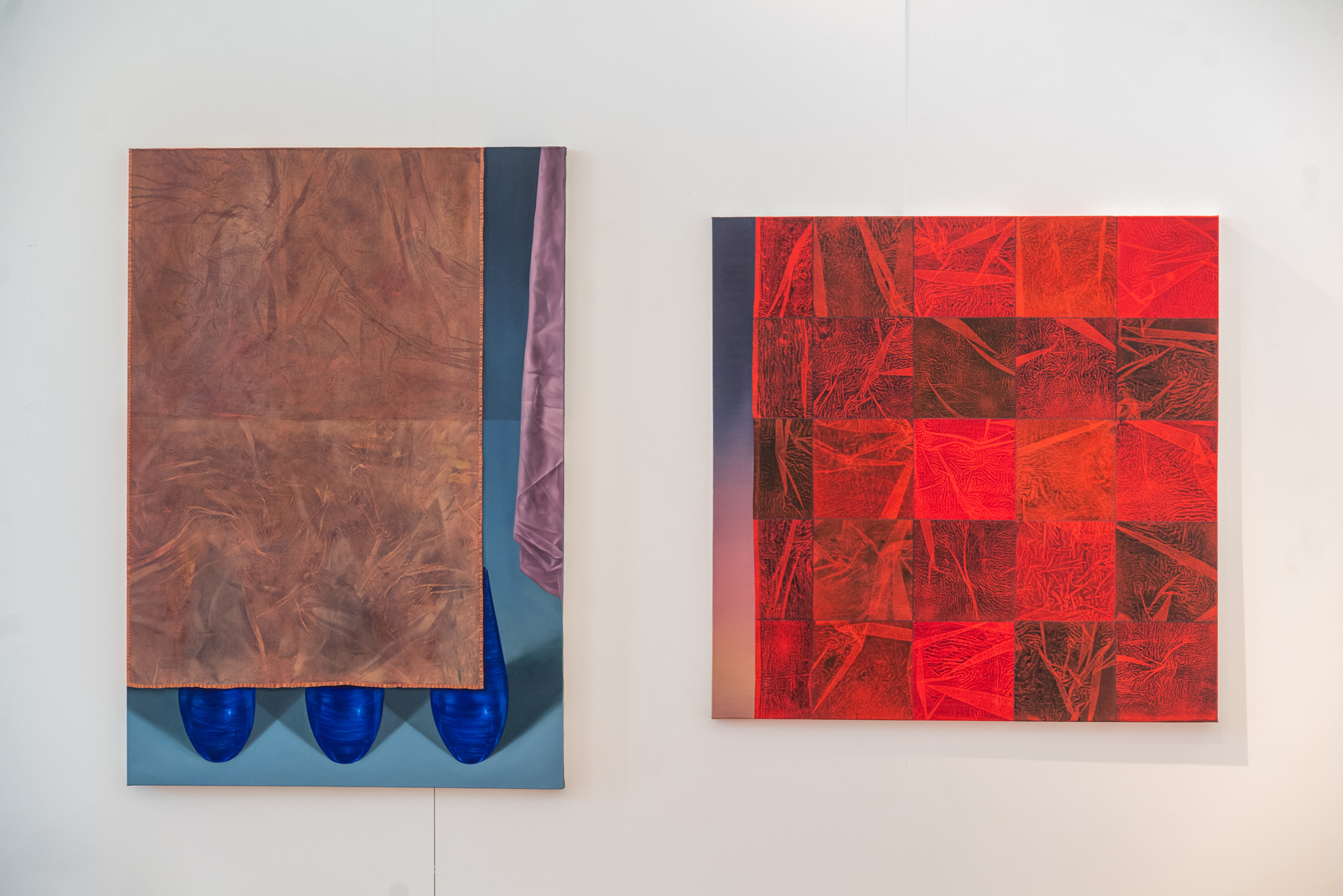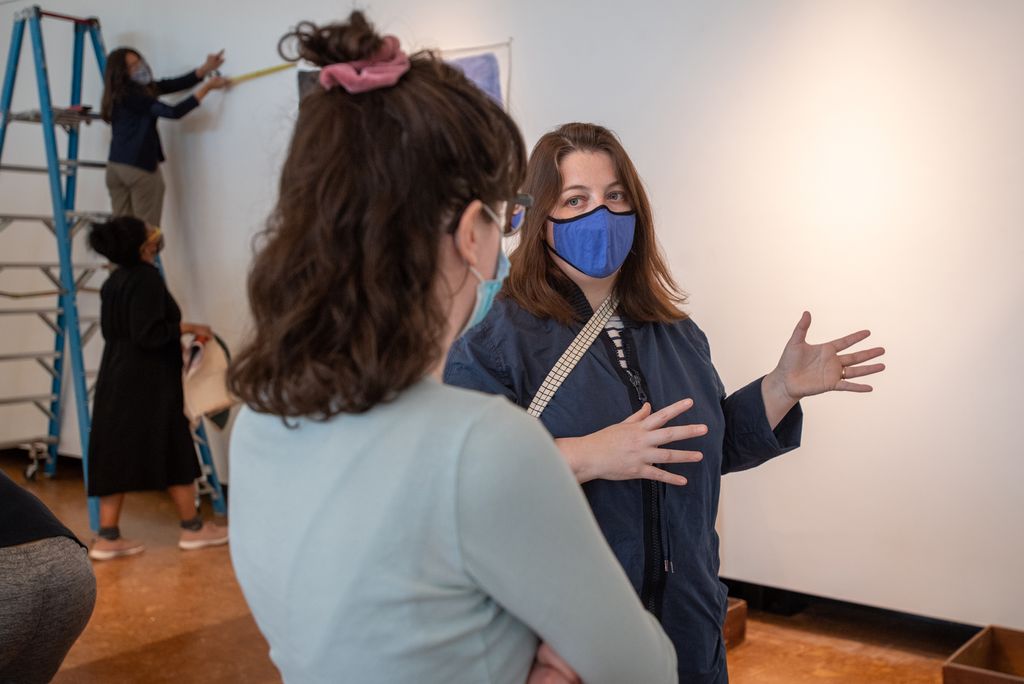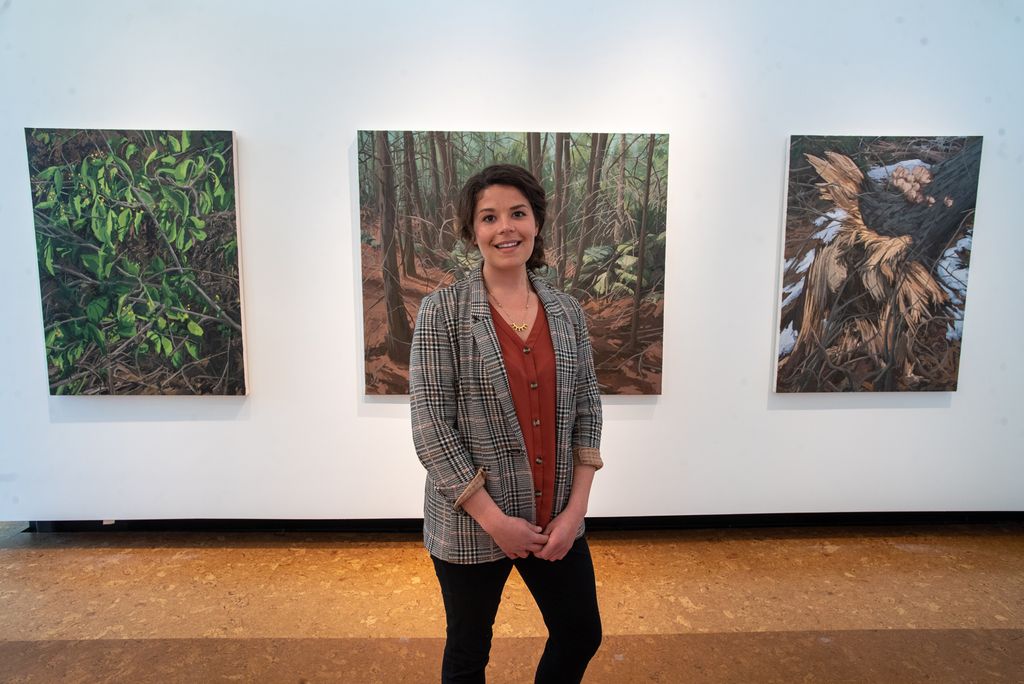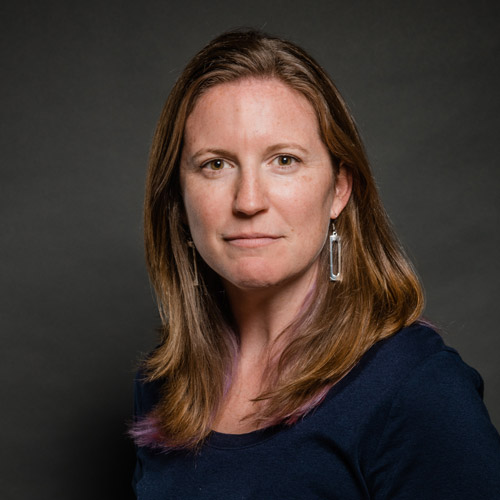MFA Painting Thesis Exhibition Highlights the Work of 17 Talented 2021 Grads

This year’s MFA Painting Thesis Exhibition, now on view at the Stone Gallery, showcases 34 works by 17 students. These two untitled works are by Danielle Fretwell (CFA’21).
MFA Painting Thesis Exhibition Highlights the Work of 17 Talented 2021 Grads
Show is at the Stone Gallery through April 26
When Bradley Milligan entered the College of Fine Arts, he saw himself as a traditional painter, working with oils. But during his two years in the Graduate Painting program his approach to painting underwent a significant transformation. Today he uses elements of sculpture and construction to create what he describes as “freestanding, built paintings” that consider issues of masculinity, race, and American politics.
Milligan (CFA’21) is one of 17 artists whose exciting work can be seen in this year’s MFA Painting Thesis Exhibition, now on view at the Faye G., Jo, and James Stone Gallery through April 26. There are 34 paintings, representing the culmination of the artists’ thesis work, in the 2021 show.

Josephine Halvorson, a CFA professor of art and chair of graduate studies in painting, says the diverse exhibition reflects the individual way each artist has developed their own artistic practice over their two years at BU. “They’ve each demonstrated breadth and depth in their artistic research,” Halvorson says. “By breadth, I mean they have experimented, they have reached out to different histories, discourses, and ideas. By depth, I mean they have given themselves permission to follow these inquiries into places that they haven’t gone before.”
Milligan uses visual tropes and signifiers of rural America to consider contemporary American politics. One of his two pieces in the show is a wall, constructed of various types of fencing, which he built himself. “Notions of vulnerability and loss run through my work, creating a tension between an artwork’s appearance and the larger issues which I allude to through my subject matter,” Milligan writes in his artist’s statement. “My working process allows me to explore these themes and their relation to rural Americana aesthetics and “The American Dream.”
Halvorson says Milligan’s work shares a common thread with that of Amanda Hawkins (CFA’21), another of the thesis exhibition artists. Hawkins’ thesis examines the ecology of the New England forest, mainly where it has been disrupted. Both painters, Halvorson notes, are examining the damage done to the American landscape—the former in terms of politics and the latter in terms of the environment.

Hawkins has three paintings, all acrylic on canvas, in the exhibition: Oriental Bittersweet, Former Property Line, and Disturbance #3. The first depicts an invasive vine that is killing other plant species and uprooting trees in forests across much of the United States, the second is a landscape with a rock wall, and the third is a painting of a fallen tree.
Discussing Former Property Line, the artist says the centuries-old rock walls that weave through New England denote former property lines and were originally used to mark farmers’ pastures. “What’s really funny about these rock walls is that they symbolize past cultures that have lived on the lands that we’re currently on. They also symbolize new growth of the forest around these walls,” Hawkins says. “I think that’s something worth celebrating through painting.”
To research her subject matter, she says, she often just walked in various forests throughout Massachusetts until she came across something that captured her attention.

“Prior to graduate school my art was just about witnessing beauty in nature, and I’ve come to realize that there’s a much more complex relationship between humans and nature that I was leaving out,” Hawkins says.
Her artist statement explores this notion further: “The subject matter of my paintings—fallen trees, invasive species, rock walls—isolate moments of past ecological events and human interventions that demonstrate the trauma, vulnerability and resilience of the forest. The forest floor, in all it’s entanglements of underbrush and invasive species, tells a long story of human movement, colonization, and globalism.”
Nearly all of the 2021 MFA graduate painting students returned to Boston this year for an in-person learning experience, after having to work remotely last spring. Halvorson says every one of them worked hard to make this possible. Since the artists’ access to their campus studios is so important, each of them carefully followed COVID-19 health protocols.
Kaitlyn Malinowski (CFA’21) says that having a studio to work in again after abruptly shifting to virtual learning last year from her rented apartment has made a huge difference in her work.
“I felt like I was dying at home. I have an apartment, so I can’t get paint on the floor,” she says. “But in my studio I’m scraping paint off the floor or getting it everywhere. Being back in the studio and being able to paint big and go full-force is so important.”

Malinowski has two pieces in the exhibition—large, colorful paintings that reveal detailed images of swirling hair. Her inspiration for this work is memories of her childhood home, where her mom made toupees for a living. Last semester she focused on portraying toupees in a “pathetic” light, “as a symbol for the male ego.”
For her thesis, Malinowski says, she wanted to make the hair more feminine and infuse parts of herself into the work, noting that a younger version of herself could never have imagined painting such a delicate subject on such a large scale, with bold composition and colors.
“I feel like I got braver in my subject matter,” she says. “To use that type of color palette, I think you need to be bold and brave. I’m calling attention to myself in a way that I’m not comfortable with always, but I’m getting there.”
Among other paintings in the show are abstracts by Bridget Bailey (CFA’21) that use specific symbols and icons that “speak to…a perpetually evolving personhood,” and explore “the private self and the public self,” her artist statement says; works by Danielle Fretwell (CFA’21), who says in her artist statement that her pieces “interrogate the space between painting and photography” and “question the objectivity of the photographic image in relation to the subjectivity of painting”; and an exploration of empty architectural spaces by Josh Rondeau (CFA’21). His life-size rendering of what appears to be a nondescript interior is a show-stopper. Standing before the untitled painting, viewers feel they’re almost about to enter into the space he’s depicted.
Halvorson says she couldn’t be prouder of this year’s artists and the exhibition they have mounted. “I don’t think there’s been a harder time or a more important time to make art, at least in my lifetime,” she says. “When I think about what these students have accomplished in the face of the challenges that they’ve faced over the last year, it really is remarkable and hopeful.”
The 2021 MFA Painting Thesis Exhibition is at the Faye G., Jo, and James Stone Gallery, 855 Commonwealth Ave., through April 26. Gallery hours are Monday to Friday, 11 am to 5 pm. Because of the pandemic, exhibition visitors are limited to on-campus BU students, faculty, and staff.

Comments & Discussion
Boston University moderates comments to facilitate an informed, substantive, civil conversation. Abusive, profane, self-promotional, misleading, incoherent or off-topic comments will be rejected. Moderators are staffed during regular business hours (EST) and can only accept comments written in English. Statistics or facts must include a citation or a link to the citation.